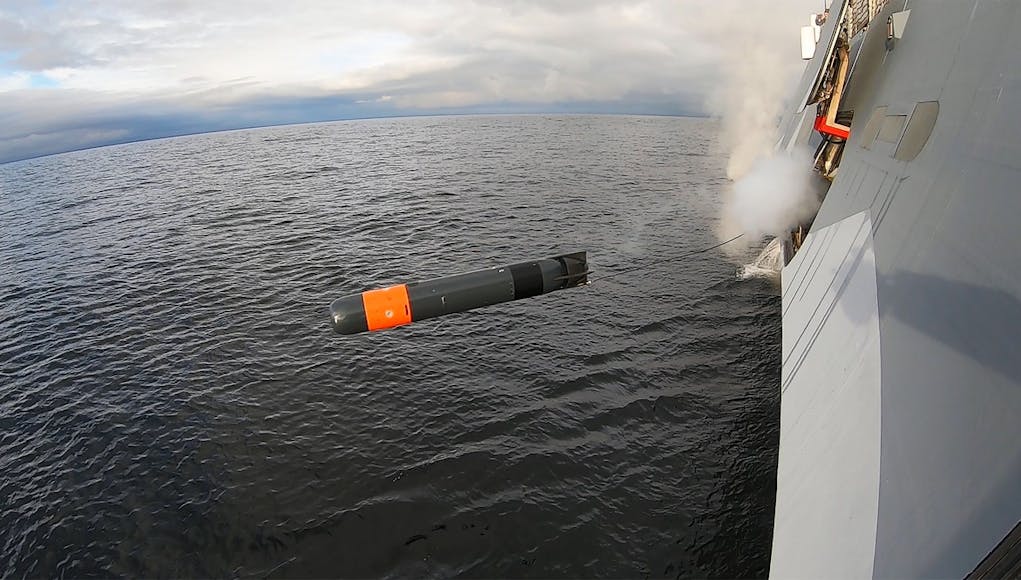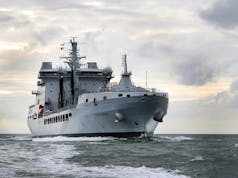Saab has, together with the Swedish Defence Materiel Administration and Swedish Armed Forces, conducted the first tests with the Saab Lightweight Torpedo from a corvette and a submarine.
The tests are the first of its kind for the new torpedo and were undertaken during February and March 2020 at sea ranges outside Karlskrona, on Sweden’s east coast in the Baltic Sea.
“The tests were conducted from a Gotland-class submarine and from a Visby-class corvette. The purpose of the firings was to verify that the torpedo can be safely launched from the vessels, which also included verification of the integration on the vessels as well as SLWT’s target seeker.”
“The Saab Lightweight Torpedo will provide the Swedish and Finnish Navy with the ability to deter and if necessary destroy hostile underwater and surface threats. Having completed these tests successfully is a major milestone in this joint project,” says Görgen Johansson, Head of Saab’s business area Dynamics.
The development of the torpedo commenced with an order from the Swedish Defence Materiel Administration (FMV) in 2016, and is to be deployed on Sweden’s submarine fleet and corvettes. In January 2018, the Finnish Navy placed an order for the SLWT, as a part of the Squadron 2000 Mid-Life Upgrade Programme.
The Finnish Navy will operate the system on-board the upgraded Hamina-class vessels as well as the new Pohjanmaa-class corvettes of the Squadron 2020 Programme.














Another one for the shopping basket.
Where it will remain….probably!
Not really sure how useful a lightweight torpedo would be in practice.
The size of the craft that it can take out would be extremely small and the ranged limited and at that point the guns of the ship are likely to be equally effective.
Is this not designed for the close confines of the Baltic and Swedish islands! Possibly against Russian underwater threats?
I don’t know enough about torpedo tech, but i am going to assume that if the sub is in range of a lightweight torpedo then the surface ship is probably already sunk.
If its hiding in inlets and fiords (?) then is there not a chance they nip out and catch them with Ivan’s pants down?
Lightweight torpedo’s are designed for platforms which cant carry a full size torpedo, for example small ships and aircraft. They have a smaller warhead and shorter range but the idea is they will be deployed closer to the target than a ship would be firing a conventional torpedo (for example in coastal waters and bays the engagement range would be a lot shorter due to land obstruction).
I seem to remember years ago when they were searching for a suspected Russian underwater submarine or other vehical in the Baltic over quite a long period and it never was explained as to whether it was real or imagined through the complex business of finding and identifying threats in the difficult Coastal waters there. I suspect under such considerations an agile lightweight torpedo might well be more practical than anything heavier. Detection ranges could be quite short and spasmodic even today I suspect and quick response a priority I can imagine a cat and mouse game between hunter and hunted in those difficult conditions even today. Remember a German submarine managed to operate unknown out of a Northern Ireland cove for a period during the war.
You might be interested in this 11min YT video on a Collins class using coastal noise to avoid detection in order to achieve a shooting solution on a US destroyer during an exercise. I doubt the sub would have gone as close in reality since their periscope was also detected, it was just to demonstrate they could and get the photos.
https://www.youtube.com/watch?v=d8Kv4rqR6RQ
This Baltic ASW lark always reminds me of the Whiskey on the Rocks fiasco. They were convinced Spetsnatz were also operating down there on the seabed, as tracks were found. So the story goes.
Why do we need this when we have Stingray? Not up on my Torpedo tech but I understand our Stingray and Spearfish Torpedoes are still relevant?
In future we will only be able to launch from choppers and subs, shouldn’t our new type 26 frigates have the ability to launch torpedoes?
Quoting from the save the royal navy site-
Magazine Torpedo Launch System
“specification for the Type 26 frigate does not include mTLS, although it was included in the design options under consideration as late as 2014. It is still possible mTLS may be fitted but it is unclear at this point.”
The merlin helicopter will remain the best submarine killing option for the T26 so they say
fitted “for but not with” springs to mind
We will be continuing to use the Stingray as Daniele above mentioned
Funny though as a have we ordered the 9 Poseidon P-8A fitted with the MK 54 which is thought to be a little inferior to Stingray!
It is interesting that in the early days of Stingray it was both reported as world leading and fundamentally ineffective against potential threats, I never have had resolved which it is ever since. But yes I would presume with ongoing updates it’s probably pretty much likely to be as effective within the limitations of lightweight torpedos as the above especially when considering operational and regional differences and needs between our respective forces.
Sting Ray Ineffective? Never heard that.
The latest version has new electronics, warhead, motor and battery updates.
Every time we let a EVT Exercise variant ( Runner with no warhead just instruments and an inflatable recovery aid) loose at a Sub it was classed as a hit.
The thing is even designed to go around again even if it hits the sub but at the wrong angle for an effective shaped charge detonation. During initial trials when it was first under development the miss distance was input incorrectly to the test weapon by the Boffins and the sub was hit repeatedly by it going round and around and attacking again and again until the battery ran out.
Oh how us Skimmers laughed!
Very relevant.
The Saab torpedo Is designed to excel in the littoral not open ocean. Sting Ray and Spearfish are open ocean weapons. Sting Ray could do a job in the littoral but the saab weapon has the advantage of wire guidance and a rechargeable, not sea water battery
All the other parts that the Saab weapon has Sting Ray has. SR will be a lot faster and deeper diving. Interesting to see that they went for a Li battery. The varied waters of the Baltic would not ideally suit a Saltwater battery.
As far as I can see is its their version of Stingray which I believe is still effective and quite smart. This probably goes a bit further with littorals probably being the focus. In terms of Spearfish as far as I can gather it’s pretty much a world leader not sure what littoral capability is but its not really SSN territory.
Yes spot on I think this weapon with its spe is list capabilities will I’m sure be very important for Sweden and neighbours, way overdue even some might claim, but our navy already has what it needs in weapons of this nature, even if the flexibility of delivery systems might be up for debate.
Good to see it can be fired from various types of platform
Length: 2.850 mm
Diameter: 400 mm
Weight: approx. 340 kg
Speed: 10- to 40+ kts
Endurance: 20+ km, 1+ hrs
Depth: 300+ m
Homing system: active/passive, fully digital sonar
Proximity fuse: multi-beam sonar
Propulsion: pumpjet (ducted rotor/stator)
Energy: lithium-based rechargeable battery
Warhead: IM compliant, omnidirectional, PBX
Communication: galvanic wire/optic fibre
Slightly off topic but does anyone know how successful the stealthy Visby class corvette is at evading radar and anti-ship missiles? Why don’t navies adopt stealthy ships in the same way as aircraft are going? Wouldn’t something more akin to the Visby class be a better choice than the Type 31 for general patrol missions in contested environments, permanently forward deployed with rotating crews? Wouldn’t the Visby class be better at escorting Russian ships out of UK waters, Falkland patrols and surely better at protecting UK tankers in the gulf? Speed and stealth would surely give an edge against would-be aggressors?
Outside my expertise, but i would guess that the Visby has been designed to blur into the ground clutter as it is meant to operate close to shore. Operating in open water and i suspect that its stealthy design would fall apart fast as i doubt they could fit radar absorbing panels to the hull as the water would destroy them fast.
I can’t see how speed would really give a ship the edge; no ship is going to outrun a missile in a fight.
Also, stealth in those scenarios you list isn’t incredibly useful. In terms of escorting ships in the Gulf and of Russian ships close to UK waters, the point is that they are on show and are willing & able to respond if provoked.
Im terms of ships around the Falklands, similar really. The ship there is largely to show that the Falklands are protected. It’s not what the ship can do right there at the time, but showing that much bigger and badder will follow should Argentina attempt any shenanigans.
It’s not about outrunning a missile in flight, but outrunning the kill chain from detection to attack. The idea is to run out, fire missiles, and duck back in. All going well they might never even leave the coastal clutter, or be able to dart back in before the enemy can acquire and launch, while the enemy would be caught in the open.
Visby would make a better LCS than the LCS. Stealth & speed seem to be of use in the littorals, I guess because transit time between hiding places is shorter and obviously small RCS helps the hiding.
All RN ships have stealth features including T31 at almost 30knts it’s no slouch either.
But, if you need a vessel to travel some distance & do multiple missions, RAS, carry marines etc. it has to be big, as well as also more practical in terms of docking, using large helicopters this means stealth has to be sacrificed as well as speed.
Making a bigger ship stealthy to the extent of Visby is more expensive look at USN’s Zumwalt and even this has to make some practical compromises.
In terms of escorting Russian ships stealth is not important you’re going in to visual range anyway. A River 2 maybe slightly up armed is fine as is T31 if in UK waters.
In terms of edge normally RN vessels are escorting non stealthy vessels any way & submarines are also a big threat. As stated above they have stealth just not extreme stealth so may resemble a fishing boat size on radar rather than a dinghy.
In the specific operating conditions the Scandinavians operation in I can see stealth as an advantage but only because the littoral landscape does most of the work for you. Totally different in open water. Indeed reports in US military circles seem to have changed the use scenario for their very stealthy littoral ships because they no longer consider that they could survive in their designed close in role against weapon systems falling into the hands of even low level onshore protagonists. The whole balance of their usefulness is now in question but then in their case fjords and rugged little populated coast lines won’t be their prime likely scenario.